
Vol. 15 No. 3 |
Winter 2005-06 |
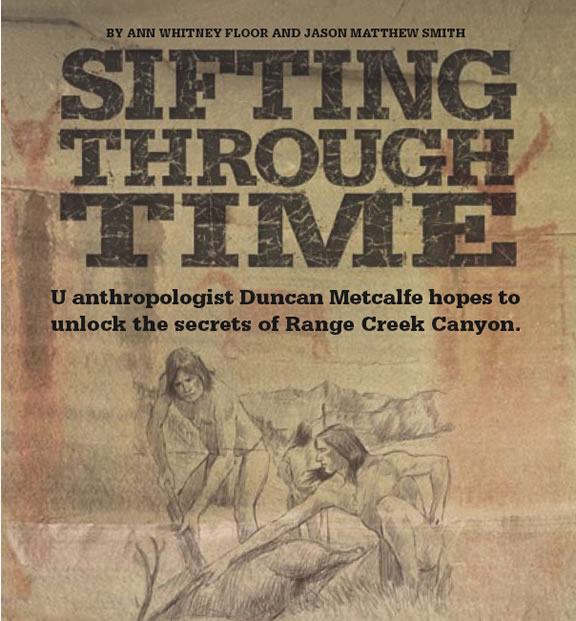
ILLUSTRATIONS
BY RANDALL ROYTER
PHOTOS BY ANN WHITNEY FLOOR AND ERIC KANKAINEN
On a map, Range Creek Canyon resembles a narrow leaf, with small tributaries like veins feeding into Range Creek. It is a quiet, isolated place some three hours southeast of Salt Lake City, accessible only by foot or horseback. Tucked away in Utah’s Book Cliffs, the canyon is littered with hundreds if not thousands of artifacts from the Fremont culture that thrived there from around 500 to 1350 A.D.
But something happened to the Fremont people around 1350 A.D. They suddenly vanished, either by disaster or design, and left behind remnants of their lives at the edge of the desert. And at Range Creek, their ancient homes—small pithouses dotted throughout the valley—are filled with pottery shards still in pristine condition. The sites in the lower canyon are largely untouched by modern humans—no litter, no bullet holes in the sandstone, no names scratched into the rock art panels. It is as if the Fremont stood up five minutes before your arrival, brushed off their knees, and filed out of their homes to disappear over the ridgeline. Gone.
Archaeological preservation is as much a battle to mitigate damage from modern-day artifact hunters, well-meaning history buffs, and bored teenagers as it is a quest to uncover the past. And Range Creek has been remarkably preserved from vandals and curiosity seekers. This is primarily because of lanky rancher Waldo Wilcox, former owner of the land and a stickler for private property rights.
For 50 years, Wilcox and his family kept the lower canyon closed to the public. Then, in 2001, he quietly sold the site to the federal government for $2.5 million but retained the mineral rights to the property—just in case. Last year, ownership was transferred to the State of Utah; today, the Utah Division of Wildlife Resources (DWR) owns the land, and the University of Utah, through its Department of Anthropology and the Utah Museum of Natural History, collaboratively manage the 1,500-acre lower ranch. The University is in its fourth year of conducting research in the canyon.
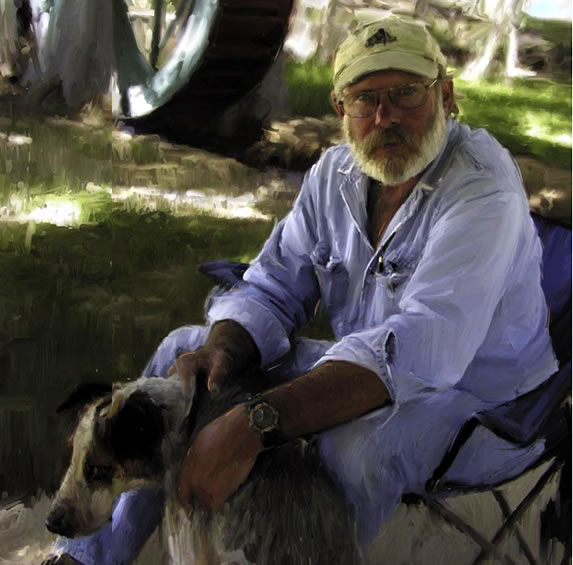 |
Duncan
Metcalfe with his blue heeler, Sarah. |
The director of the Range Creek research site for the U is Associate Professor of Anthropology Duncan Metcalfe, a curator at the museum. Today, returning for his fourth season at Range Creek, Metcalfe heads down the washboard road in his dusty Dodge truck, 12 miles to the Wilcox Ranch, where he runs a field school for undergraduate and graduate research students. “Range Creek will provide at least a dozen master’s theses and dissertations,” Metcalfe says over the truck’s creaking and rattling. “This is rare, because it will allow one generation of students to build on the knowledge of the previous one.”
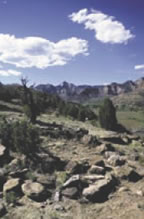 |
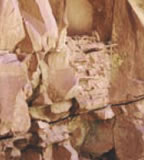 |
Although dedicated to his students, Metcalfe keeps returning to Range Creek for his own reasons, too—simply to satisfy his own scientific curiosity about the Fremont folk and what happened to them. The son of a Harvard M.D. whose research focused on how pregnant women transfer oxygen to their fetuses, Metcalfe comes by his taste for science honestly.
Wearing a light blue work shirt neatly tucked into faded jeans, a tan Adidas cap covering most of his graying hair, and a full professorial beard, Metcalfe looks the part of the rough and tumble anthropologist. He’s responsible for overseeing the collection and cataloguing of the hundreds of rock art panels, cliffside granaries and pit houses, and the arrowheads, pottery, and basketry collected from the ground in Range Creek Canyon. It’s no simple task: As of September 2005, researchers had scoured between five and 10 percent of the canyon’s surface and recorded more than 300 sites. Once they explore it all, they expect to find between 1,000 and 3,000 sites, most of them in pristine condition.
Metcalfe eases the truck to a stop, pointing out Locomotive Rock, a high outcropping that holds several ancient granaries. And a little farther down the road, he nods toward the “Deluxe Apartment in the Sky,” a series of dwellings perched at the midpoint near an arch spanning sheer cliffs, hundreds of feet high. Metcalfe parks the truck and scrambles up some rocks to a granary, where the Fremont stashed food. Right at eye-level on a rock near the granary is the faint impression of a trapezoid figure painted with red ochre and a mysterious yellow substance, its source unknown to researchers.
The Fremont have long been an enigma to anthropologists, and one of the central questions Metcalfe hopes Range Creek can answer is why they adopted and then seemed to abandon agriculture in a period of just 1,000 years. “If we can address that question, it will have worldwide implications,” he says. Scientists are keeping an eye on the findings coming out of Range Creek because it could illuminate an important corner of ancient human history in which a culture went from being hunter-gatherers to agrarians, then back to hunter-gatherers.
“There’s been tons of ink spilled on paper by scientists about why people got into agriculture and how that led to civilization,” says Metcalfe. “But the fact is it didn’t always lead to civilization. It led some very intelligent people to stop doing it and return to hunting and gathering. So if we can begin to figure that out, we’ll have an important purchase on why humans make the decisions they do. And,” he says, “that’s fundamentally what anthropologists want to know.”
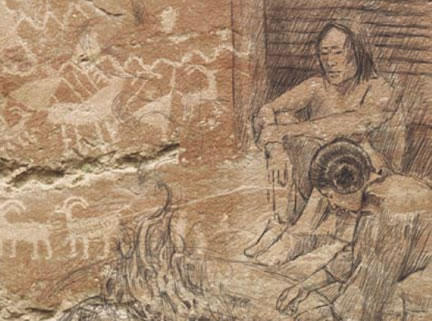 As
he steers the truck into the ranch, Metcalfe’s blue heeler Sarah
bounds out to greet him, and Metcalfe seems at home. The ranch is an
eclectic collection of buildings, used as a base camp for researchers.
The structures are slowly being upgraded but still lack electricity.
Out here, life is much as it was in the American West decades ago, with
all the drama and turmoil of a frontier settlement.
As
he steers the truck into the ranch, Metcalfe’s blue heeler Sarah
bounds out to greet him, and Metcalfe seems at home. The ranch is an
eclectic collection of buildings, used as a base camp for researchers.
The structures are slowly being upgraded but still lack electricity.
Out here, life is much as it was in the American West decades ago, with
all the drama and turmoil of a frontier settlement.
Last winter a skunk died under the floorboards of one of the cabins, and the odor still lingers. For Metcalfe and the students it is as palatial and comfortable as Salt Lake’s Grand America—in backcountry like this, you take what you can get. And you had better be handy, because if something goes wrong, it’s a long hike back to civilization. “Out here,” says Metcalfe, “if a gas line clogs up, I can bypass it with a mechanical pencil.”
So far from traffic, noise, and light pollution, Metcalfe should sleep like the dead. But he says he sometimes lies awake at night in his bunk, worrying. “I’m up at three in the morning making lists of what needs to be done,” he says. And he frets over the unknowns, the wild-card disasters—someone falling from the high cliffs, fire in the canyon. Or he might think back to the first time he saw Range Creek.
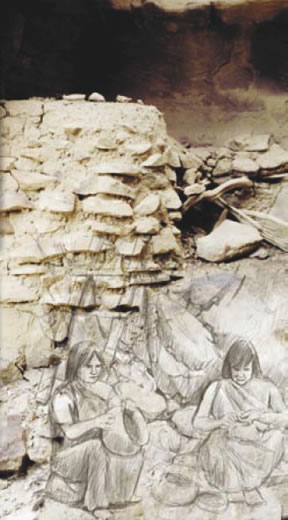 Before
his first visit in 2001, Metcalfe had heard about the lost city of the
Fremont in Range Creek Canyon but didn’t fully appreciate its
significance. One day, he finally made time to check it out, with Waldo
Wilcox as his guide.
Before
his first visit in 2001, Metcalfe had heard about the lost city of the
Fremont in Range Creek Canyon but didn’t fully appreciate its
significance. One day, he finally made time to check it out, with Waldo
Wilcox as his guide.
Standing together amid the fragrant sagebrush, a hot sun beat down on them. Wilcox pointed to a distant cliff. “You can hike up there, cut around the back, walk up that ridge line, and look underneath the arch and you’ll find a pit house village,” he said.
Metcalfe was doubtful, but he sent three teaching assistants up to see what they could find. After five or six failed attempts, they were finally successful, recording six sites on the way up and a pit house village, now called the Deluxe Apartment in the Sky, just as Wilcox had described. Metcalfe could hardly believe it. There were three or four grand pit houses, and worn out metates (stone blocks with a shallow concave surface, used for grinding corn or other grains)— “not as if people were up there for a weekend,” he thought. “This is a very substantial occupation.” Some 700 years ago the canyon hummed with life. Voices echoed off the walls. The Fremont not only lived here, but more than likely, flourished. In Range Creek, Metcalfe stood toe-to-toe with the past, on the brink of a great opportunity to discover how the Fremont lived, and, just maybe, what happened to them.
Metcalfe had hoped to keep the discovery of Range Creek quiet for another five years, but last summer a reporter from the Associated Press broke the story. “The cat is out of the bag, and people all over the world are finding out about Range Creek,” he says. “The big question now is how to protect the site from being loved to death.”
Since Range Creek was purchased with public funds the goal is to provide some public access. Although a management plan is still in draft form, a one-day permit system allows access to visitors on foot or horseback, but no cars, camping, or loitering after dark.
Now that he’s back at Range Creek, Metcalfe will settle into the work of sifting through the soil and collecting radiocarbon dating samples, tiny shards of pottery, and debitage, the small chips of stone created in the tool-making process.
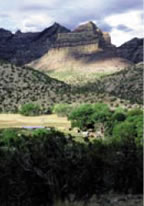 |
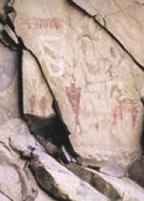 |
Yet the work is just beginning, and there’s still a long way to go. Last year, researchers conducted an intensive survey of the land and gathered up every surface artifact within 50 meters of either side of the road to keep occasional visitors from walking off with a piece of anthropological evidence in their pockets. They also mapped and collected everything on the sites near scenic features like Locomotive Rock. “Gathering these fragile artifacts will provide a baseline understanding for all the sites,” says Metcalfe, an opportunity lost forever at nearby Nine Mile Canyon, where most of the artifacts have been destroyed by vandals. It’s been said that Range Creek today is what Nine Mile Canyon was 100 years ago.
“And by collecting, it means we’ve actually picked up everything we could fi nd in the area and taken it to the Archaeological Center, Department of Anthropology, and the Utah Museum of Natural History,” he says. The collection will be housed there, and some of the artifacts will be loaned to other museums in the region.
As one of the most important archaeological discoveries in recent decades, Range Creek has the potential to grant scientists a whole new way of looking at the West’s pre-history, provided that Metcalfe and others can continue to protect the sites. It’s the kind of discovery that would infl ate any anthropologist’s ego. But not Metcalfe’s.
He calmly pats Sarah on the head and says, “It’s largely serendipity. I’ve just been lucky. I’m not any smarter, I’m not any better-educated than the guys I went to school with. I was just in the right place at the right time.”
—Ann Floor BFA’85 is a writer in the U’s communications department. Jason Matthew Smith is editor of Continuum.
RANGE CREEK DATING TECHNIQUES
• Tree-ring dating involves cutting cross-sections of tree trunks, like slicing bread, and then counting the number of rings from the bark-side inward to determine the exact age of the tree. This method is very precise temporally, allowing archaeologists to date the year a piece of timber was cut. Also known as dendrochronology,tree-ring dating is based on variations in thickness of annual growth rings, which reflect variations in the climate during the lifetime of a tree. Over relatively long periods of time (about 30 years), this pattern of tree-ring thickness variation is unique and allows the matching of prehistoric samples with a master sequence (those from a known cutting date).
• Dendroclimatology uses the sametree rings but looks at the variationin the rings as a consequence of environmental changes across time.Wider rings indicate a year with favorable growth conditions (plenty of water and a long frost-free season); very narrow rings, the opposite. A black smudge is evidence of a fire. Examination of the rings creates a picture of how theclimate has changed.
• Both pounded and gas-powered coring machines take core samples from the soft marshes of places like Cherry Meadows, which show changes in pollen types and frequencies over time (as determined by radiocarbon dating and the presence of volcanic ash falls), allowing paleoecologists to reconstruct transformations in regional vegetation. Assistant Professor of Geography Andrea Brunelle and her graduate students are conducting these studies in the canyon.
• Developed in 1949, radiocarbondating determines the approximate age of archaeological specimens by measuring the amount of carbon-14 contained in an organic sample. Most of the absolute dates from Range Creek have been determined by radiocarbon tests, and most have been derived from corn cobs, since corn is both a domesticate (a plant that has been adapted to grow in a human environment) and an annual. The majority of the radiocarbon dates from Range Creek fall in the neighborhood of A.D. 1050.
• Cut bank studies focus on the alluvia (sediments) that are exposed when the water level of an area drops and exposes the bank. These are similar to the studies of core samples, but the cut banks allow scientists to examine broad expanses of the alluvium, facilitating the study of fluvial hydraulics, pollen, and fi re history of Range Creek. Brunelle and her graduate students are leading this study.
• Pack rat midden studies involve
the examination of these rodents’ nests. Rats gather plant material
for their nests and solidify it with their urine, which is thick like
molasses (because they don’t drink any water), gluing the nest together.
Rat middens can survive for tens of thousands of years, so using radiocarbon
testing to date samples provides a look at plant remains, making it possible
to identify the different species. In the canyon, this is giving researchers
a close look at what the vegetation was like about a thousand years ago.
Adjunct Associate Professor in Geography Larry Coats and his graduate
students are leading this study.